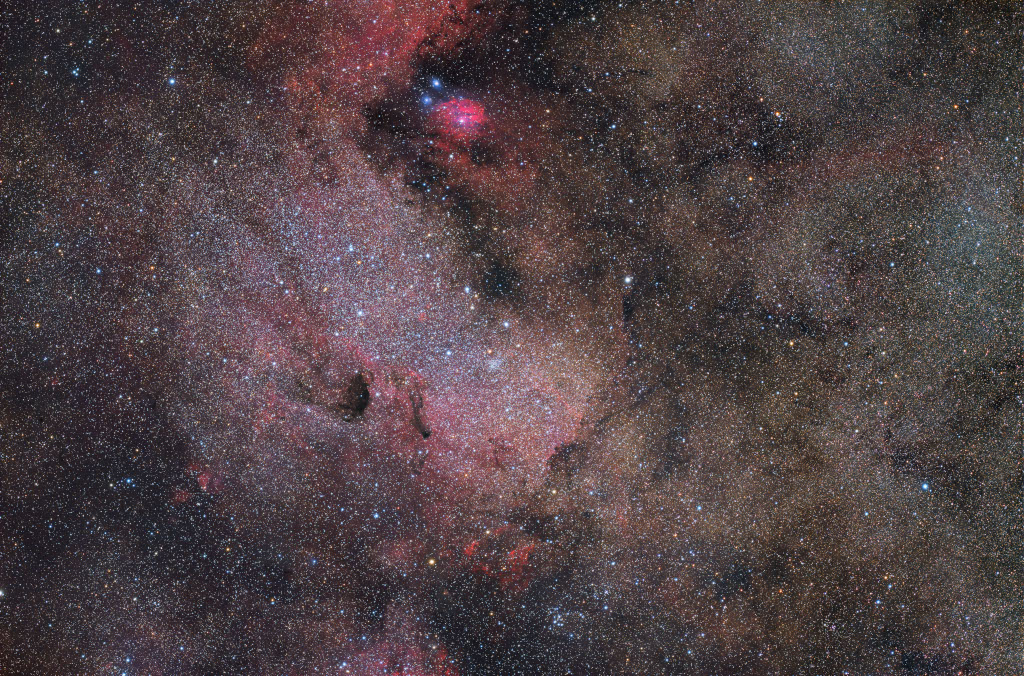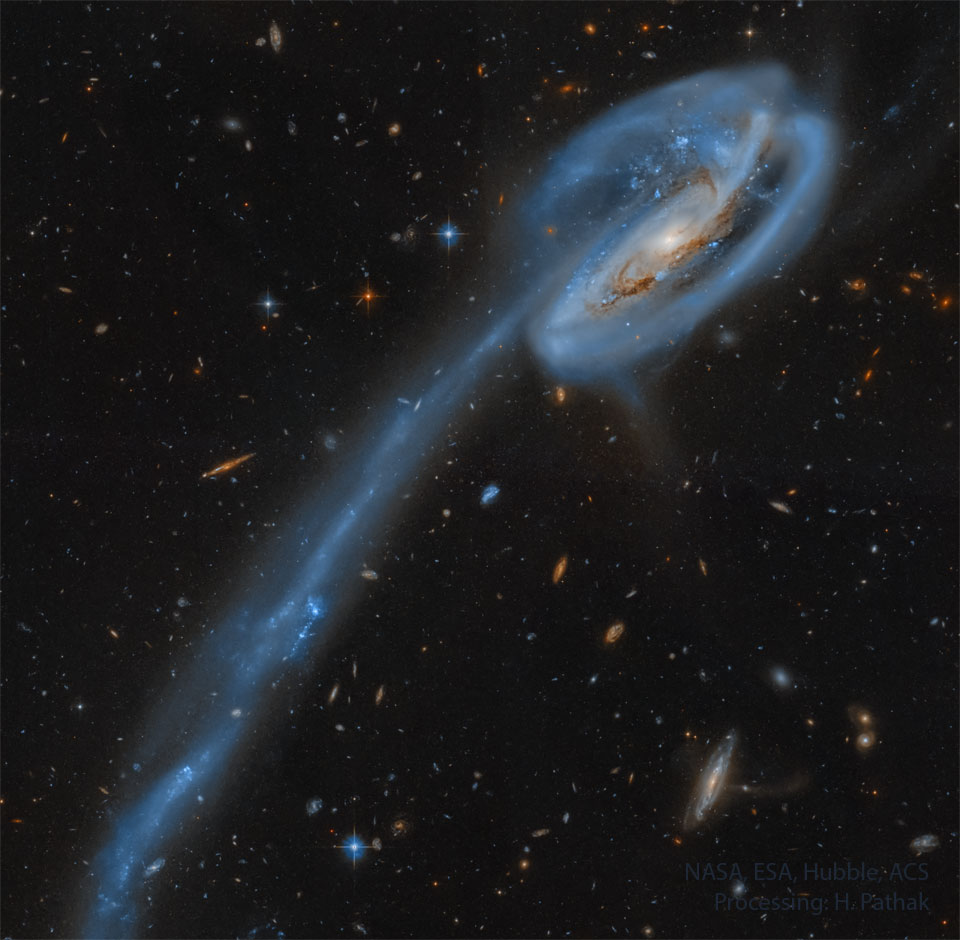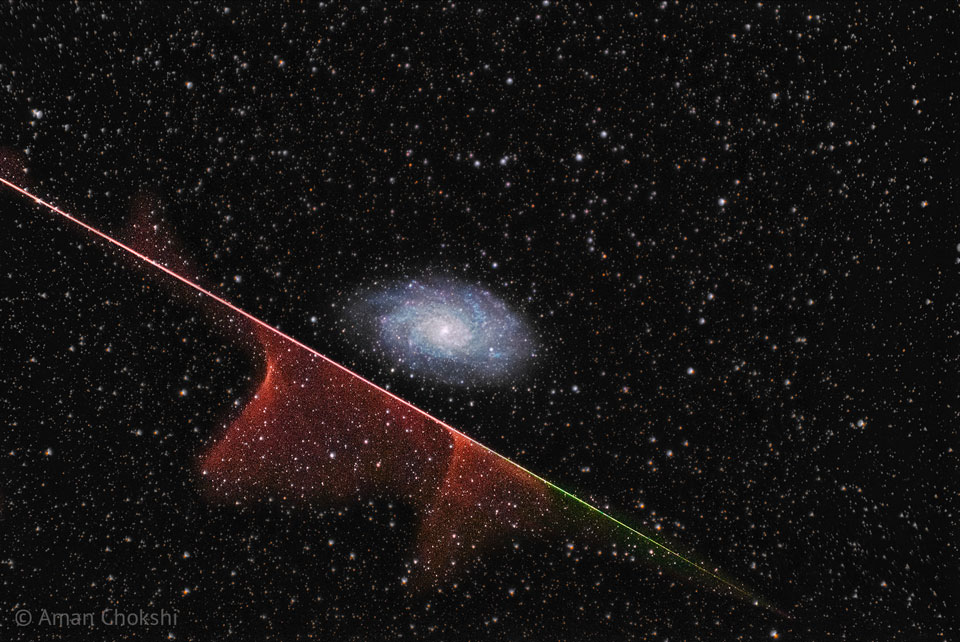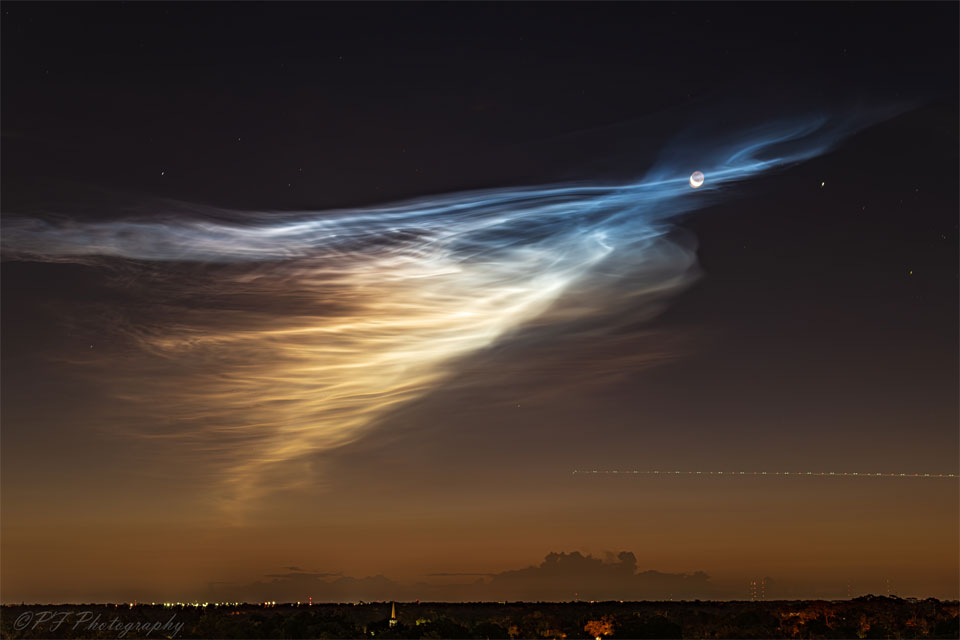Nombre total de pages vues
18/07/2024
ASTRONOMY - Messier 24: Sagittarius Star Cloud
2024 July 18
Image Credit & Copyright: Christopher Freeburn
Explanation: Unlike most entries in Charles Messier's famous catalog of deep sky objects, M24 is not a bright galaxy, star cluster, or nebula. It's a gap in nearby, obscuring interstellar dust clouds that allows a view of the distant stars in the Sagittarius spiral arm of our Milky Way galaxy. Direct your gaze through this gap with binoculars or small telescope and you are looking through a window over 300 light-years wide at stars some 10,000 light-years or more from Earth. Sometimes called the Small Sagittarius Star Cloud, M24's luminous stars are left of center in this gorgeous starscape. Covering over 6 degrees or the width of 12 full moons in the constellation Sagittarius, the telescopic field of view includes dark markings B92 and B93 near the center of M24, along with other clouds of dust and glowing nebulae toward the center of the Milky Way.
17/07/2024
SANTé/MEDECINE - Robert Koch découvreur du bacille de la tuberculose
ASTRONOMY - Villarrica Volcano Against the Sky
2024 July 17
Video Credit & Copyright: Gabriel Muñoz; Text: Natalia Lewandowska (SUNY Oswego)
Explanation: When Vulcan, the Roman god of fire, swings his blacksmith's hammer, the sky is lit on fire. A recent eruption of Chile's Villarrica volcano shows the delicate interplay between this fire -- actually glowing steam and ash from melted rock -- and the light from distant stars in our Milky Way galaxy and the Magellanic Clouds galaxies. In the featured timelapse video, the Earth rotates under the stars as Villarrica erupts. With about 1350 volcanoes, our planet Earth rivals Jupiter's moon Io as the most geologically active place in the Solar System. While both have magnificent beauty, the reasons for the existence of volcanoes on both worlds are different. Earth's volcanoes typically occur between slowly shifting outer shell plates, while Io's volcanoes are caused by gravitational flexing resulting from Jupiter's tidal gravitational pull.
16/07/2024
ASTRONOMY - Cometary Globules
2024 July 16
Image Credit & Copyright: Mark Hanson & Martin Pugh, Observatorio El Sauce
Explanation: What are these unusual interstellar structures? Bright-rimmed, flowing shapes gather near the center of this rich starfield toward the borders of the nautical southern constellations Pupis and Vela. Composed of interstellar gas and dust, the grouping of light-year sized cometary globules is about 1300 light-years distant. Energetic ultraviolet light from nearby hot stars has molded the globules and ionized their bright rims. The globules also stream away from the Vela supernova remnant which may have influenced their swept-back shapes. Within them, cores of cold gas and dust are likely collapsing to form low mass stars, whose formation will ultimately cause the globules to disperse. In fact, cometary globule CG 30 (on the upper left) sports a small reddish glow near its head, a telltale sign of energetic jets from a star in the early stages of formation.
15/07/2024
ASTRONOMY - The Tadpole Galaxy from Hubble
2024 July 15
Image Credit: Hubble Legacy Archive, ESA, NASA; Processing: Harshwardhan Pathak
Explanation: Why does this galaxy have such a long tail? In this stunning vista, based on image data from the Hubble Legacy Archive, distant galaxies form a dramatic backdrop for disrupted spiral galaxy Arp 188, the Tadpole Galaxy. The cosmic tadpole is a mere 420 million light-years distant toward the northern constellation of the Dragon (Draco). Its eye-catching tail is about 280 thousand light-years long and features massive, bright blue star clusters. One story goes that a more compact intruder galaxy crossed in front of Arp 188 - from right to left in this view - and was slung around behind the Tadpole by their gravitational attraction. During the close encounter, tidal forces drew out the spiral galaxy's stars, gas, and dust forming the spectacular tail. The intruder galaxy itself, estimated to lie about 300 thousand light-years behind the Tadpole, can be seen through foreground spiral arms at the upper right. Following its terrestrial namesake, the Tadpole Galaxy will likely lose its tail as it grows older, the tail's star clusters forming smaller satellites of the large spiral galaxy.
14/07/2024
ASTRONOMY - Meteor Misses Galaxy
2024 July 14
Credit & Copyright: Aman Chokshi
Explanation: The galaxy was never in danger. For one thing, the Triangulum galaxy (M33), pictured, is much bigger than the tiny grain of rock at the head of the meteor. For another, the galaxy is much farther away -- in this instance 3 million light years as opposed to only about 0.0003 light seconds. Even so, the meteor's path took it angularly below the galaxy. Also the wind high in Earth's atmosphere blew the meteor's glowing evaporative molecule train away from the galaxy, in angular projection. Still, the astrophotographer was quite lucky to capture both a meteor and a galaxy in a single exposure -- which was subsequently added to two other images of M33 to bring up the spiral galaxy's colors. At the end, the meteor was gone in a second, but the galaxy will last billions of years.
SANTé/MEDECINE - John Dalton et la première description du daltonisme
13/07/2024
ASTRONOMY - Noctilucent Clouds over Florida
2024 July 9
Credit & Copyright: Pascal Fouquet
Explanation: These clouds are doubly unusual. First, they are rare noctilucent clouds, meaning that they are visible at night -- but only just before sunrise or just after sunset. Second, the source of these noctilucent clouds is actually known. In this rare case, the source of the sunlight-reflecting ice-crystals in the upper atmosphere can be traced back to the launch of a nearby SpaceX rocket about 30 minutes earlier. Known more formally as polar mesospheric clouds, the vertex of these icy wisps happens to converge just in front of a rising crescent Moon. The featured image -- and accompanying video -- were captured over Orlando, Florida, USA about a week ago. The bright spot to the right of the Moon is the planet Jupiter, while the dotted lights above the horizon on the right are from an airplane.
ASTRONOMY - Red Sprites and Circular Elves Lightning over Italy
2025 December 23 Red Sprites and Circular Elves Lightning over Italy Image Credit & Copyright: Valter Binotto Explanation: What's...
-
2022 September 26 All the Water on Planet Earth Illustration Credit: Jack Cook, Adam Nieman, Woods Hole Oceanographic Institution ; Data ...
-
2025 May 11 The Surface of Venus from Venera 14 Image Credit: Soviet Planetary Exploration Program , Venera 14 ; Processing & Copyri...






